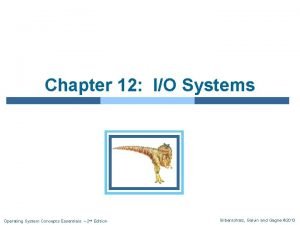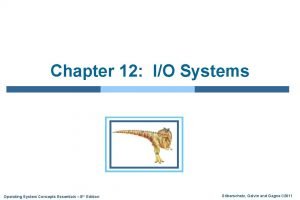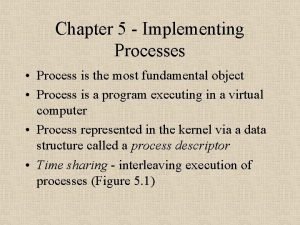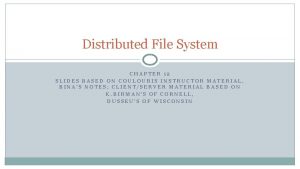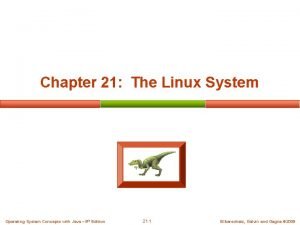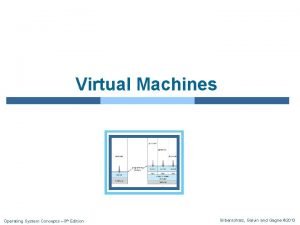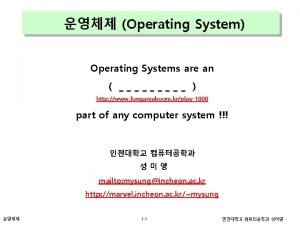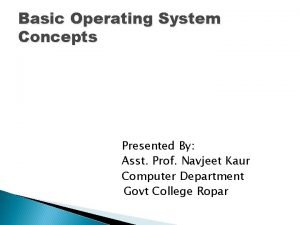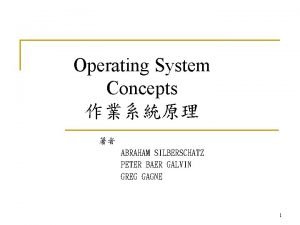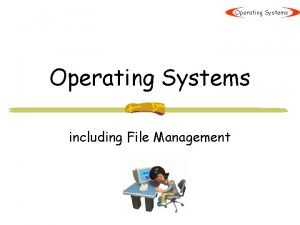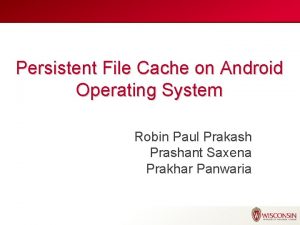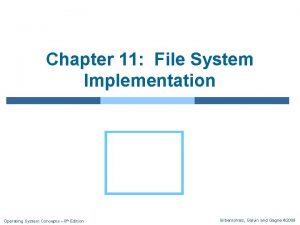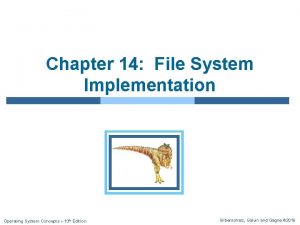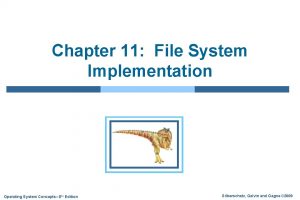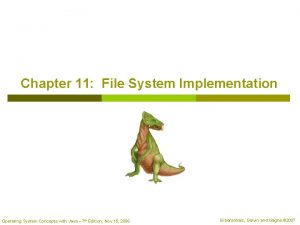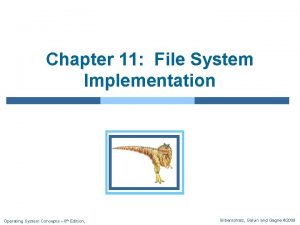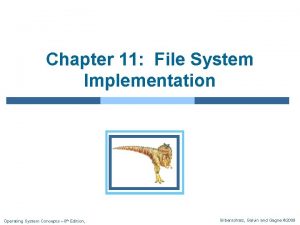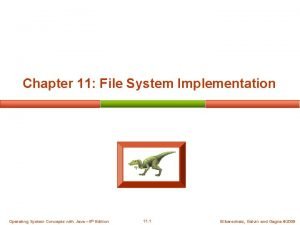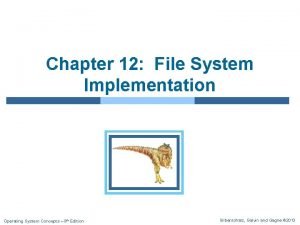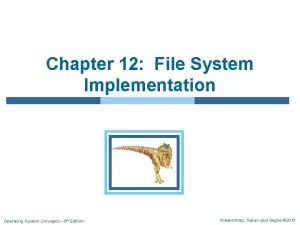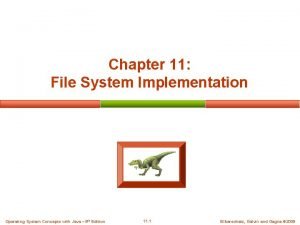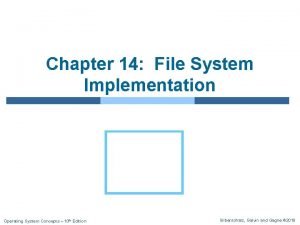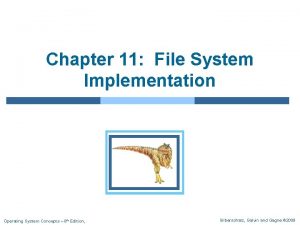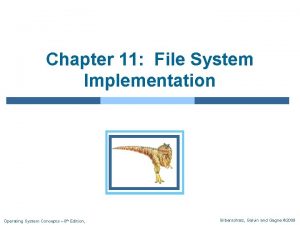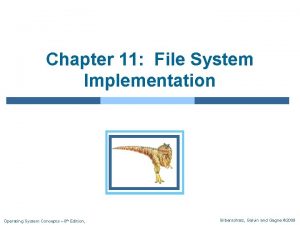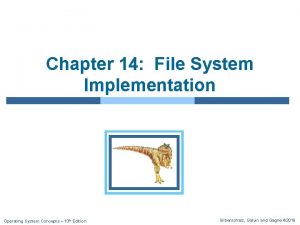File System Implementation Operating System Concepts Essentials 2

























- Slides: 25

File System Implementation Operating System Concepts Essentials – 2 nd Edition Silberschatz, Galvin and Gagne © 2013

File System Implementation n File-System Structure n File-System Implementation n Directory Implementation n Allocation Methods n Efficiency and Performance n Recovery Operating System Concepts Essentials – 2 nd Edition 10. 2 Silberschatz, Galvin and Gagne © 2013

File-System Structure n n n File structure l Logical storage unit l Collection of related information File system resides on secondary storage (disks) why? l Provided user interface to storage, mapping logical to physical l Provides efficient and convenient access to disk by allowing data to be stored, located retrieved easily Disk provides in-place rewrite and random access l I/O transfers performed in blocks of sectors (usually 512 bytes) n File control block – storage structure consisting of information about a file n Device driver controls the physical device n File system organized into layers Operating System Concepts Essentials – 2 nd Edition 10. 3 Silberschatz, Galvin and Gagne © 2013

Layered File System Operating System Concepts Essentials – 2 nd Edition 10. 4 Silberschatz, Galvin and Gagne © 2013

Allocation Methods - Contiguous n An allocation method refers to how disk blocks are allocated for files: n Contiguous allocation – each file occupies set of contiguous blocks l Best performance in most cases l Simple – only starting location (block #) and length (number of blocks) are required l Problems include finding space for file, knowing file size, external fragmentation. Operating System Concepts Essentials – 2 nd Edition 10. 5 Silberschatz, Galvin and Gagne © 2013

Allocation Methods - Contiguous n Example : n The file ‘mail’ in the following figure starts from the block 19 with length = 6 blocks. Therefore, it occupies 19, 20, 21, 22, 23, 24 blocks Operating System Concepts Essentials – 2 nd Edition 10. 6 Silberschatz, Galvin and Gagne © 2013

Operating System Concepts Essentials – 2 nd Edition 10. 7 Silberschatz, Galvin and Gagne © 2013

Contiguous Allocation n Mapping from logical to physical n Logical address= byte location within a file n Physical address= block address +offset within that block n Let LA be the Logical address and let block size=512 byte n Q=LA/512 (BLOCK NUMBER) n R=LA%512 (OFFSET) Q Block to be accessed = Q + starting address Displacement into block = R Operating System Concepts Essentials – 2 nd Edition 10. 8 LA/512 R Silberschatz, Galvin and Gagne © 2013

Contiguous Allocation n Mapping from logical to physical Q LA/512 R Block to be accessed = Q + starting address Displacement into block = R Operating System Concepts Essentials – 2 nd Edition 10. 9 Silberschatz, Galvin and Gagne © 2013

Allocation Methods - Linked n Linked allocation – each file a linked list of blocks l File ends at nil pointer l No external fragmentation l Each block contains pointer to next block l No compaction, external fragmentation l Free space management system called when new block needed l Improve efficiency by clustering blocks into groups but increases internal fragmentation l Locating a block can take many I/Os and disk seeks Operating System Concepts Essentials – 2 nd Edition 10. 10 Silberschatz, Galvin and Gagne © 2013

Chained Allocation n Each file is a linked list of disk blocks: blocks may be scattered anywhere on the disk. block = pointer n Simple: need only starting address. n Free-space management: no waste of space. n No random access. You have to follow the link from the first block to the end. Operating System Concepts Essentials – 2 nd Edition 10. 11 Silberschatz, Galvin and Gagne © 2013

Chained/Linked Allocation Example Operating System Concepts Essentials – 2 nd Edition 10. 12 Silberschatz, Galvin and Gagne © 2013

Linked List Allocation Using a Table in Memory Operating System Concepts Essentials – 2 nd Edition 10. 13 Silberschatz, Galvin and Gagne © 2013

Linked Allocation Operating System Concepts Essentials – 2 nd Edition 10. 14 Silberschatz, Galvin and Gagne © 2013

Operating System Concepts Essentials – 2 nd Edition 10. 15 Silberschatz, Galvin and Gagne © 2013

Operating System Concepts Essentials – 2 nd Edition 10. 16 Silberschatz, Galvin and Gagne © 2013

Allocation Methods – Linked (Cont. ) n FAT (File Allocation Table) variation l Beginning of volume has table, indexed by block number l Much like a linked list, but faster on disk and cacheable l New block allocation simple Operating System Concepts Essentials – 2 nd Edition 10. 17 Silberschatz, Galvin and Gagne © 2013

File-Allocation Table Operating System Concepts Essentials – 2 nd Edition 10. 18 Silberschatz, Galvin and Gagne © 2013

Allocation Methods - Indexed n Indexed allocation l n Each file has its own index block(s) of pointers to its data blocks Logical view Operating System Concepts Essentials – 2 nd Edition 10. 19 Silberschatz, Galvin and Gagne © 2013

Operating System Concepts Essentials – 2 nd Edition 10. 20 Silberschatz, Galvin and Gagne © 2013

Operating System Concepts Essentials – 2 nd Edition 10. 21 Silberschatz, Galvin and Gagne © 2013

Example of Indexed Allocation Operating System Concepts Essentials – 2 nd Edition 10. 22 Silberschatz, Galvin and Gagne © 2013

Performance n Best method depends on file access type l Contiguous great for sequential and random n Linked good for sequential, not random n Declare access type at creation -> select either contiguous or linked n Indexed more complex l Single block access could require 2 index block reads then data block read l Clustering can help improve throughput, reduce CPU overhead Operating System Concepts Essentials – 2 nd Edition 10. 23 Silberschatz, Galvin and Gagne © 2013

Recovery n Consistency checking – compares data in directory structure with data blocks on disk, and tries to fix inconsistencies l Can be slow and sometimes fails n Use system programs to back up data from disk to another storage device (magnetic tape, other magnetic disk, optical) n Recover lost file or disk by restoring data from backup Operating System Concepts Essentials – 2 nd Edition 10. 24 Silberschatz, Galvin and Gagne © 2013

Log Structured File Systems n Log structured (or journaling) file systems record each metadata update to the file system as a transaction n All transactions are written to a log l n A transaction is considered committed once it is written to the log (sequentially) The transactions in the log are asynchronously written to the file system structures l When the file system structures are modified, the transaction is removed from the log n If the file system crashes, all remaining transactions in the log must still be performed n Faster recovery from crash, removes chance of inconsistency of metadata Operating System Concepts Essentials – 2 nd Edition 10. 25 Silberschatz, Galvin and Gagne © 2013
 Operating system concepts essentials
Operating system concepts essentials Operating system concepts essentials
Operating system concepts essentials File-file yang dibuat oleh user pada jenis file di linux
File-file yang dibuat oleh user pada jenis file di linux File system in operating system
File system in operating system Ufs4.0
Ufs4.0 File system in operating system
File system in operating system Implementation of process in operating system
Implementation of process in operating system Distributed file system implementation
Distributed file system implementation Operating system concepts, 10th edition
Operating system concepts, 10th edition Linux operating system concepts
Linux operating system concepts Operating system concepts with java
Operating system concepts with java Operating system concepts 6th edition
Operating system concepts 6th edition Operating system concepts 9
Operating system concepts 9 Real time operating system concepts
Real time operating system concepts 교보 drm
교보 drm Operating system concepts chapter 8 solutions
Operating system concepts chapter 8 solutions Operating system concepts chapter 5 solutions
Operating system concepts chapter 5 solutions Operating system concepts chapter 5 solutions
Operating system concepts chapter 5 solutions Basic concepts of os
Basic concepts of os Operating system concepts 11th
Operating system concepts 11th Peter baer galvin
Peter baer galvin File management in operating system
File management in operating system Android manifest persistent
Android manifest persistent File management in operating system
File management in operating system Distributed file system definition
Distributed file system definition In a file-oriented information system, a transaction file
In a file-oriented information system, a transaction file
